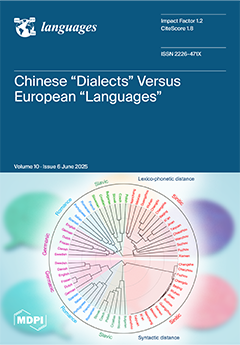This paper presents a comprehensive synchronic and diachronic analysis of the Sino-Vietnamese negative prefixes
bất (Chinese 不
bù),
vô (無
wú), and
phi (非
fēi), examining their historical development and modern usage in Vietnamese, with a comparative perspective on their
[...] Read more.
This paper presents a comprehensive synchronic and diachronic analysis of the Sino-Vietnamese negative prefixes
bất (Chinese 不
bù),
vô (無
wú), and
phi (非
fēi), examining their historical development and modern usage in Vietnamese, with a comparative perspective on their Chinese equivalents. By investigating the interaction between these prefixes and Vietnamese sentential negators—such as the native
chẳng and the Chinese-derived
không—the study explores the evolution of negation in Vietnamese over several centuries. The research draws on a corpus of three bilingual Classical Chinese–Vietnamese translations of Confucius’s
Analects from the 17th, 19th, and 21st centuries, two written in traditional
Nôm script and one in the modern
Quốc ngữ alphabet. This corpus provides valuable insights into linguistic shifts driven by language contact in Vietnam. The findings reveal that in the 17th century, the Sino-Vietnamese prefixes
bất,
vô, and
phi were largely absent, with native
chẳng dominating. By the 19th century,
chẳng persisted, but
không emerged as a sentential negator, and
bất appeared, both reflecting Chinese forms and demonstrating innovative uses. In the 21st century,
không became the dominant negator, with
bất and
vô seeing increased usage, reflecting broader trends of linguistic modernization. This study situates these changes within the broader context of 20th-century East Asian literacy expansion, where Japan played a pivotal role in disseminating modernized Chinese-based vocabulary. By examining the selective adaptation and integration of Sino-Vietnamese elements, this paper contributes to a deeper understanding of language contact, syntactic influence, and lexical innovation in the evolving Vietnamese lexicon.
Full article





